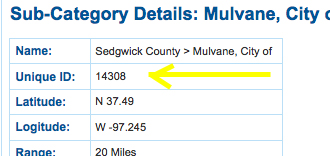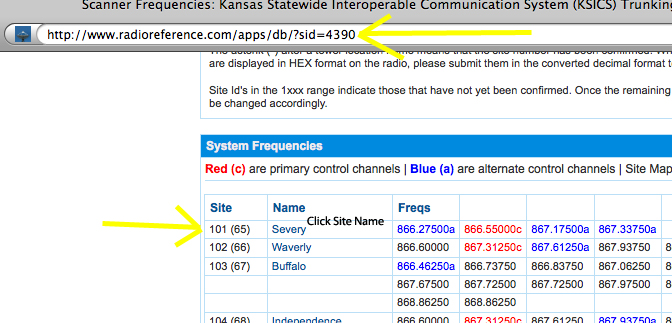RR Wiki Extensions
From The RadioReference Wiki
The RadioReference Wiki has some custom extensions. Many of these can be used to display dynamic data in the database of custom pages of information. They are currently as follows:
Contents
Displaying Conventional Frequencies
You can display conventional frequencies stored in the database with the following tag:
<freqsubcat>xxx</freqsubcat>
Where:
xxx = The Frequency Subcategory ID
To find the subcat ID, click on the left arrow, and the following results:
Click the "View Subcategory Details" button, and the following will result with the Unique ID.
Displaying Frequencies for a Trunked System
You can display the frequencies for a Trunked Radio System in the database with the following tag:
<site>xxx|sssss</site>
Where:
xxx = The Trunked Radio Database sid number sssss = The system's Unique DB Site ID
To find the "sid" for a trunked system, look in the URL for each trunked system entry:
Next to the site number (shown circled on the left) is the site name. If there is more than one site, you must choose which site name you wish to display. In this case, click on Severy

Use the Unique DB Site ID as the second value for the tag.
So in this case, the correct site tag would read:
<site>4390|8562</site>
Displaying Talkgroups
You can display the talkgroups for a Trunked Radio System in the database with the following tag:
<tg>xxx|yyyyy</tg>
Where:
xxx = The Trunked Radio Database sid number yyyyy = The unique ID that's shown in the 2nd image below
The SID is found using the method above. This is the first value in the tag.
To find the unique ID, go down to the desired talkgroups and point at the left arrow. The following display results:
Click on it, and the following image results. Use the Unique ID as the 2nd value in the tag.
In this case, the complete tag would read:
<tg>4390|10257</tg>
If you want to display all talkgroups for the system in one single table, use "All" as the Unique ID. For example:
<tg>4390|All</tg>
Displaying Recently Updated Frequencies and Talkgroups
You've submitted changes to the database, they've been entered - why can't I see the changes on the Wiki?
The reason is that you are getting your old page from the Wiki's page cache. The cache not only stores a local copy of the page, but also stores the last execution of any extensions. What is needed, therefore, is a way to flush the cache so that the extensions pull data from the database again. To accomplish this, install the Refreshpage template somewhere on the page (preferably at the end of the article, or the last call to the extensions). It only needs to show up once on the article; all extension calls on the page will be refreshed at the same time. It is written with the <small> tag so that the text does not overly distract the user from reading the rest of the article. The use of the Refreshpage template is strongly encouraged.
To install it, copy the code below, substituting the URL of the page being edited after the ‘’Pageurl=” statement. Remove the nowiki tags from either end of the statement;
{{Refreshpage |Pageurl=Place the URL of the page you wish to refresh here}}
If you are viewing the page from a redirected link (commonly from the Nationwide database listing), be sure to press the Page tab on the left to obtain the URL. Don't use the redirected URL.
This template will cause a blue ‘Refresh’ statement (in small print) to be generated. Pressing this will cause the page to be flushed from the wiki’s queue. The wiki will then get a new copy of the page, and the extensions will execute, pulling any new data into the article.
Displaying EBay Search Results
The Ebay extension is no longer available.




